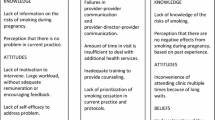Abstract
Objective: To determine the impact of stage-based smoking cessation workshops for perinatal care-providers.
Methods: A one-day workshop was designed and piloted with perinatal care-providers in Comox Valley, British Columbia. Dissemination to eight other communities followed. Preand post-questionnaires were collected from 270 care-providers. Clients (n=115) were interviewed after contact with a care-provider.
Results: Workshops increased care-provider knowledge (p<0.0001), confidence to address smoking with clients (p<0.0001), and perceived ability to help clients across the stages of change (p<0.0001). There was an increase in use of the model (p<0.0001) by careproviders, with 86% reporting changing their work with perinatal clients and 75% applying it beyond that setting. A significant shift in client readiness to change occurred during the pilot (p=0.001) and dissemination (p=0.013). Eighty percent of dissemination clients reported altering smoking behaviours as a result of intervention and 36% made at least one attempt to quit. Client satisfaction was high. Spin-off benefits included increased community collaboration, and capacity.
Résumé
Objectif: Déterminer l’influence d’une conférence, à l’intention du personnel soignant, sur l’arrêt du tabac chez les femmes enceintes.
Méthode: Nous avons conçu un atelier-pilote d’une journée, qui a été mené par des soignants périnataux dans la vallée de Comox en Colombie-Britannique, puis étendu à huit autres collectivités. Deux cent soixante-dix participants ont rempli des questionnaires avant et après l’atelier. Les clientes (n = 115) ont été interviewées par un participant à l’atelier.
Résultats: Les ateliers ont accru les connaissances des soignants (p < 0,0001), leur ont permis de parler du problème de la cigarette avec leurs clientes avec beaucoup plus de confiance (p < 0,0001) et leur ont donné la possibilité d’accroître leur aide tout au long des stages du traitement (p < 0,0001). Il y a eu une augmentation significative de l’utilisation du modèle (p < 0,0001) par les soignants: 86 % ont déclaré un changement dans leur travail avec les clientes périnatales, et 75 % ont appliqué ce modèle au-delà du cadre. On a constaté une évolution significative de l’ouverture des clientes au changement à l’étape pilote (p < 0,0001) et durant les ateliers ultérieurs (p = 0,013). Quatre-vingt p. cent des clientes des ateliers ultérieurs ont indiqué que leur utilisation du tabac avait changé en raison de l’intervention, et 36 % au moins ont essayé d’arrêter de fumer. La satisfaction des clientes était très élevée.
Similar content being viewed by others
References
Edwards N, Sims-Jones N, Hotz S. Pre and Postnatal Smoking: A Review of the Literature. Ottawa: Health Canada, 1994.
Connor FK, McIntyre L. The social demographic predictors of smoking cessation among pregnant women in Canada. Can J Public Health 1999;90(5):352–55.
Prochaska JO, DiClemente CC, Norcross, JC. In search of how people change: Applications to addictive behaviours. Am Psychol 1992;47(9):1102–14.
Caffarella, RS. Planning Programs for Adult Learners: A Practical Guide for Educators, Trainers, and Staff Developers. San Francisco: Jossey-Bass, 1994.
Schoenly L. Teaching in the affective domain. J Contin Educ Nursing 1994;25(5):109–12.
Windsor RA, Cutter G, Morris J, et al. The effectiveness of smoking cessation methods for smokers in public health maternity clinics: A randomized trial. Am J Public Health 1985;75:1389–92.
Windsor RA, Lowe JB, Perkins LL, et al. Behaviour impact and cost benefit of health education methods for pregnant smokers in public health maternity clinics: The Birmingham Trial II. Am J Public Health 1993;83:201–6.
Hjalmarson AIM, Hahn L, Svanberg B. Stopping smoking in pregnancy: Effect of a self-help manual in controlled trial. Br J Obstet Gynaecol 1991;98:260–64.
Prochaska JO, DiClemente CC, Velicer WF, Rossi, JS. Standardized, individualized, interactive and personalized self-help programs for smoking cessation. Health Psychology 1993;12(5):399–405.
Glynn TJ, Boyd GM, Gruman, JC. Essential elements of self-help/minimal intervention strategies for smoking cessation. Health Educ Q 1990;17:335–41.
Wynn M. Stopping When You’re Ready. Ottawa: Community Health Research Unit, University of Ottawa, 1995.
McDowell N, McKenna J, Naylor, PJ. Factors that influence practice nurses to promote physical activity. Br J Sports Med 1997;31(4):308–13.
DiClemente CC, Prochaska JO, Fairhurst S, et al. The process of smoking cessation: An analysis of precontemplation, contemplation and contemplation/action. J Consult Clin Psychol 1991;59:295–304.
Velicer WF, Fava JL, Prochaska JO, et al. Distribution of smokers by stage in three representative samples. Prev Med 1995;24:401–11.
Munro BH, Page, EB. Statistical Methods for Health Care Research. 2nd ed. Philadelphia: JB Lippincott, 1993;94.
Schwartz J. Review and Evaluation of Smoking Control Methods: The United States and Canada, 1978–1985. Rockville, MD: U.S. Dept. of Health and Human Services, 1987.
Adams JES. Facilitating Changes in Perinatal Smoking: A Community Development Approach. Unpublished Masters Thesis. Antigonish, Nova Scotia: St. Francis Xavier University, 1999.
Hawe P, Noort M, King L, Jordens C. Multiplying health gains: The critical role of capacity-building within health promotion programs. Health Policy 1997;37:29–42.
Author information
Authors and Affiliations
Corresponding author
Additional information
Acknowledgements: This project received support from the Community Action Initiatives Program, Tobacco Demand Reduction Strategies, Health Canada, Canadian Cancer Society, BC and Yukon Division, Upper Island/Central Coast Community Health Services Society, and BC Heart Health Demonstration Project, BC Ministry of Health Planning. The authors thank Kris Welk and Julie McCaig for their valuable assistance and acknowledge the efforts of all the perinatal women, their care-providers, and other dedicated community members who were involved in many aspects of this project.
Rights and permissions
About this article
Cite this article
Naylor, PJ., Adams, J.S. & McNeil, D. Facilitating Changes in Perinatal Smoking. Can J Public Health 93, 285–290 (2002). https://doi.org/10.1007/BF03405019
Received:
Accepted:
Published:
Issue Date:
DOI: https://doi.org/10.1007/BF03405019




